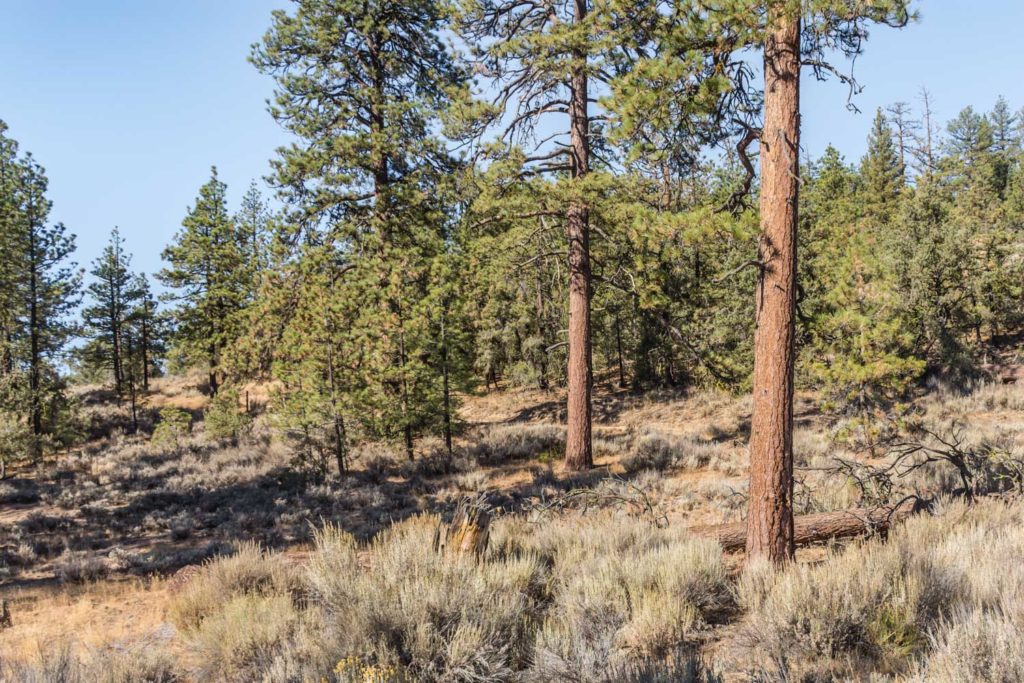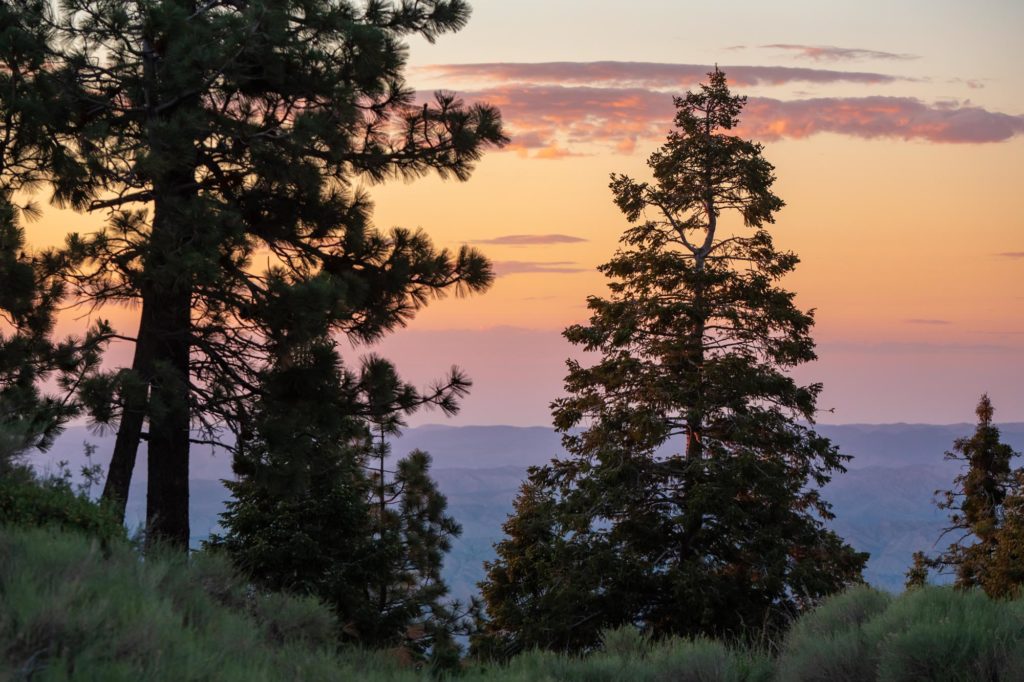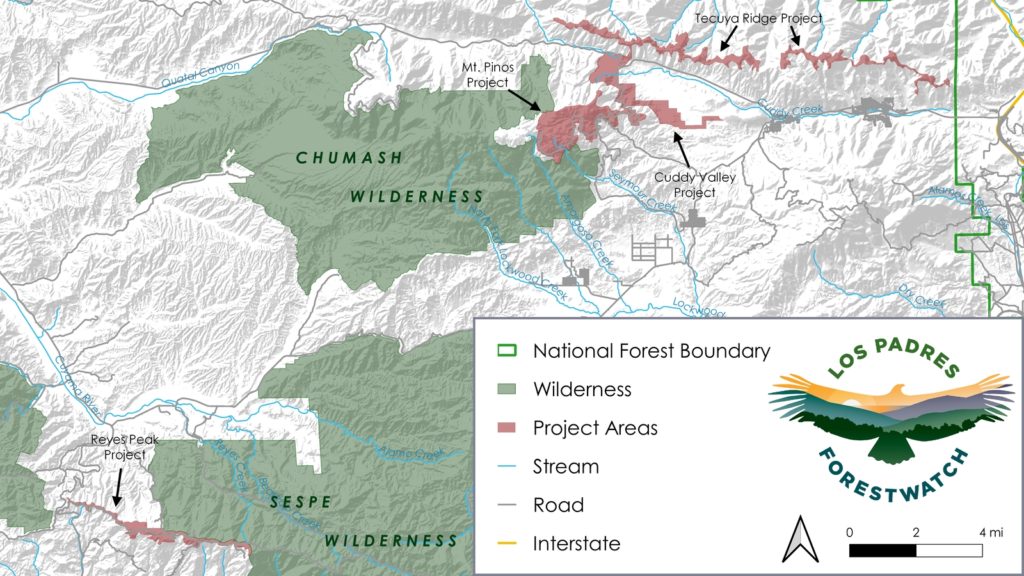Nearly four years ago, the Forest Service proposed the first in what would become a string of projects allowing commercial logging in the Los Padres National Forest. We thought an update on where the four currently proposed or approved logging projects stand is in order.
Tecuya Ridge and Cuddy Valley
Both of these projects were proposed at the same time in the spring of 2018. The Tecuya Ridge logging project encompasses 1,626 acres atop a prominent ridge on the edge of the national forest in the Mt. Pinos Ranger District. This ridge is largely covered by pinyon-juniper woodland along the south-facing slopes and Jeffrey pine forest along the ridgeline and down the north-facing slopes to some extent. Notably, we identified dozens of locations within and immediately adjacent to the project area that have been used for roosting by California condors over the past several years (according to an analysis of U.S. Fish and Wildlife Service tracking data).

The Cuddy Valley logging project extends across a 1,200-acre area adjacent to Tecuya Ridge, at the northeastern base of Mt. Pinos. The project area is almost entirely Jeffrey pine forest mixed with black oak and singleleaf pinyon pine, as well as Great Basin sagebrush in some areas. Both projects were proposed and later approved under loopholes called categorical exclusions, which the Forest Service used to avoid preparing an environmental assessment or environmental impact statement. The agency also only gave the public a single 30-day comment period to weigh in on the projects. Normally the National Environmental Policy Act (NEPA) requires that projects of this size and scope go through more robust environmental review that analyzes alternatives to the project while also affording the public more opportunities to comment and even object to the project once it’s approved.
In 2019 we partnered with the Center for Biological Diversity and John Muir Project of Earth Island Institute to challenge the Tecuya Ridge project in court due to the lack of environmental review and several violations of various environmental regulations. We argued that the loopholes used by the Forest Service did not apply when endangered species like California condors may be harmed, when there is significant scientific controversy, or when large old-growth trees will be logged from protected roadless areas. In what was perhaps an unsurprising move, three timber industry interest groups officially intervened in defense of the project, stating that they “have an economic interest at stake in this case” due to their “direct interests in the economic benefits from the implementation of the Tecuya Project.”

We then teamed up with the John Muir Project and a group of local citizens in the area to legally challenge the Cuddy Valley project. Our arguments in that case focused on the Forest Service’s inadequate analysis of whether the project would actually protect communities near Mt. Pinos or whether logging activities could even increase local wildfire risk.
Unfortunately, the judge in both cases ruled in favor of the Forest Service. Our legal team found flaws in the rulings, so in 2020, we took both cases to the Ninth Circuit Court of Appeals where a panel of judges heard our arguments early last year. We are still awaiting a decision on both cases to be issued by the panel.
While it may seem like these projects are entirely stalled for now, the Forest Service did award an Oregon-based company a contract to do much of the tree-cutting on Tecuya Ridge. It’s possible that work will start sometime this spring after the snow melts and roads to the top of the ridge are usable once again. We expect to have a decision from the Ninth Circuit by then, however, which will help guide us on any additional steps we can take to ensure that the area is protected.
Pine Mountain
As we were fighting the Tecuya Ridge and Cuddy Valley projects in court in early summer of 2020, the Forest Service proposed yet another logging project, this time along Pine Mountain Ridge in the heart of Ventura County. The project area includes 755 acres of Jeffrey pine and mixed-conifer forest as well as canyon live oak woodland and chaparral along six miles of the ridgetop. A little more than one-third of the project area is also part of the Central Coast Heritage Protection Act and will be added to the Sespe Wilderness when the bill is signed into law. As with the other two projects, the Forest Service proposed to cut live and dead trees (up to two feet in diameter in most cases, with loose stipulations for cutting trees up to five feet in diameter) using heavy equipment. Trees and other cut materials would be sold commercially as well as burned in piles on site. Over 300 acres of old-growth chaparral in the project area would also be masticated (essentially ground up into mulch). Once again the Forest Service used loopholes to expedite the project with only a single public comment period, no environmental assessment or impact statement, and no chance for concerned stakeholders to officially object to the project. You can read our nearly 100-page comment letter to learn more about our concerns with the project.

Pine Mountain is revered across the region due to its cultural, ecological, and recreational importance. Multiple Chumash groups have taken issue with the project due to potential impacts to cultural sites and the invaluable ecosystems and habitat found on the mountain. The ridge is also one of the premier destinations for hikers, campers, and climbers in the southern Los Padres National Forest. Because of its unique forests and topography, Pine Mountain is vital for several species of plants and wildlife that rely on old-growth conifer forest as well as forests growing immediately adjacent to expanses of chaparral.
Over 16,000 people submitted comments of opposition to the Forest Service, most of whom expressed concern about the likely ecological impacts of using heavy machinery to plants, soil, and water as well as the unnecessary removal of thousands of trees from across the area. Tribal leaders, elected officials, archaeologists, fire scientists, biologists, organizations, businesses, and even state agencies all submitted comments outlining serious concerns about the project, especially considering the lack of robust environmental review. Nevertheless, the Forest Service approved the project using controversial loopholes last fall. Soon after the decision, the County of Ventura Board of Supervisors and the Ojai City Council voted to officially oppose the project.
We’ve teamed up with several organizations to explore legal options for protecting Pine Mountain from destructive logging and chaparral clearing activities. Our team hopes to have an update on how we’ll be moving forward soon.
Mt. Pinos
Three projects, two lawsuits, and nearly 20,000 comments of opposition from the public later, the Forest Service announced yet another logging project in the southern Los Padres. This 1,682-acre project is located along the northeastern slope of Mt. Pinos, just next to the Cuddy Valley project area. As with the other three projects, the Forest Service is proposing to cut live and dead trees with heavy machinery, with the option for a company to do the work commercially. The project is also being proposed under the same or similar loopholes as previous projects—so only one public comment period and no robust environmental review.
Fortunately, this project hasn’t been approved yet. We’re working hard to convince the Forest Service that they should heed calls by the public, tribal leaders, elected officials, organizations, and businesses and either withdraw the project or go through the environmental assessment process before making a decision. In fact, we encourage you to let the Forest Service know how you feel about the project if you haven’t done so already. The timeline for when a decision will be issued by the agency keeps changing, with the expected decision date now in June of this year.
Local or National Issue?
Though the Trump administration hasn’t been in charge of national forests for over a year now, many of the bad policies we saw in recent years seem to have carried over into the Biden administration. We continue to see expedited logging projects proposed around California and the western U.S., typically using loopholes and justified as wildfire mitigation or forest health. Unfortunately, these damaging policies are getting a boost from the infrastructure bill that passed last year, with large sums of public funds being pumped into vegetation removal across wildland ecosystems. The Biden administration even announced a 10-year strategy for dealing with wildfires this week that is almost entirely focused on removing vegetation despite scientific scrutiny on such practices, a mountain of evidence pointing toward community-focused efforts (such as home hardening and defensible space) as being more effective wildfire mitigation tactics, and a lack of analysis into how logging in the backcountry will impact carbon storage and sequestration in our national forests. This plan has been backed and promoted by the timber industry, which will likely benefit from timber contracts and sales with the Forest Service.
Despite shifted political winds and ostensibly more focus on conservation, it seems we still have our work cut out for us over the next few years. ForestWatch will be working all angles at the federal, state, and local levels to ensure that these projects are based on sound science, developed with full transparency and public input, thoroughly evaluated with environmental studies, and most of all, are focused where they can be effective—adjacent to homes, not far out in the wildlands.








Comments are closed.